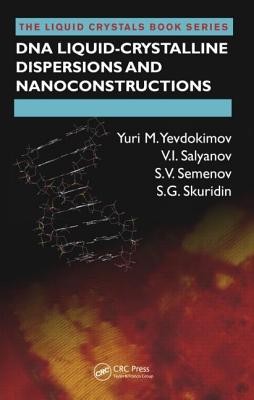
- We will send in 10–14 business days.
- Author: Yuri M Yevdokimov
- Publisher: CRC Press
- ISBN-10: 1439871469
- ISBN-13: 9781439871461
- Format: 15.5 x 23.4 x 2 cm, hardcover
- Language: English
- SAVE -10% with code: EXTRA
DNA Liquid-Crystalline Dispersions and Nanoconstructions (e-book) (used book) | bookbook.eu
Reviews
Description
The discovery of the spatial structure of the double-stranded DNA molecule is one of the greatest achievements of science. It would not be an exaggeration to say that the DNA double helix is a distinguished symbol of modern biology.
Divided into three parts, DNA Liquid-Crystalline Dispersions and Nanoconstructions covers the information presently available on the condensation of various forms of DNA and describes practical applications of the peculiar properties of the liquid-crystalline particles.- Part 1 describes the main methods used for condensation of linear high- and low-molecular mass DNA, including their complexes with polycations and circular DNA
- Part 2 compares the state and reactivity of double-stranded nucleic acid molecules fixed spatially in the liquid-crystalline as well as the same molecules under intracellular conditions
- Part 3 explains how the discovery of the fundamental principles underlying the formation of nucleic acid liquid-crystalline dispersion particles opens a gate for the operational use of these principles in the area of nanotechnology and biosensorics
With detailed coverage of DNA liquid crystals, this book provides an understanding of the information presently available on the condensation of various forms of DNA. Double-stranded nucleic acids, spatially organized in a liquid-crystalline structure, represent an important polyfunctional tool for molecular biology and nanobiotechnology. The possibility of programmed and controlled variations in the properties of these molecules and in the characteristics of their liquid-crystalline dispersions, provides wide options for the formation of biologically active three-dimensional structures with unique, widely applicable properties.
EXTRA 10 % discount with code: EXTRA
The promotion ends in 15d.01:18:51
The discount code is valid when purchasing from 10 €. Discounts do not stack.
- Author: Yuri M Yevdokimov
- Publisher: CRC Press
- ISBN-10: 1439871469
- ISBN-13: 9781439871461
- Format: 15.5 x 23.4 x 2 cm, hardcover
- Language: English English
The discovery of the spatial structure of the double-stranded DNA molecule is one of the greatest achievements of science. It would not be an exaggeration to say that the DNA double helix is a distinguished symbol of modern biology.
Divided into three parts, DNA Liquid-Crystalline Dispersions and Nanoconstructions covers the information presently available on the condensation of various forms of DNA and describes practical applications of the peculiar properties of the liquid-crystalline particles.- Part 1 describes the main methods used for condensation of linear high- and low-molecular mass DNA, including their complexes with polycations and circular DNA
- Part 2 compares the state and reactivity of double-stranded nucleic acid molecules fixed spatially in the liquid-crystalline as well as the same molecules under intracellular conditions
- Part 3 explains how the discovery of the fundamental principles underlying the formation of nucleic acid liquid-crystalline dispersion particles opens a gate for the operational use of these principles in the area of nanotechnology and biosensorics
With detailed coverage of DNA liquid crystals, this book provides an understanding of the information presently available on the condensation of various forms of DNA. Double-stranded nucleic acids, spatially organized in a liquid-crystalline structure, represent an important polyfunctional tool for molecular biology and nanobiotechnology. The possibility of programmed and controlled variations in the properties of these molecules and in the characteristics of their liquid-crystalline dispersions, provides wide options for the formation of biologically active three-dimensional structures with unique, widely applicable properties.


Reviews